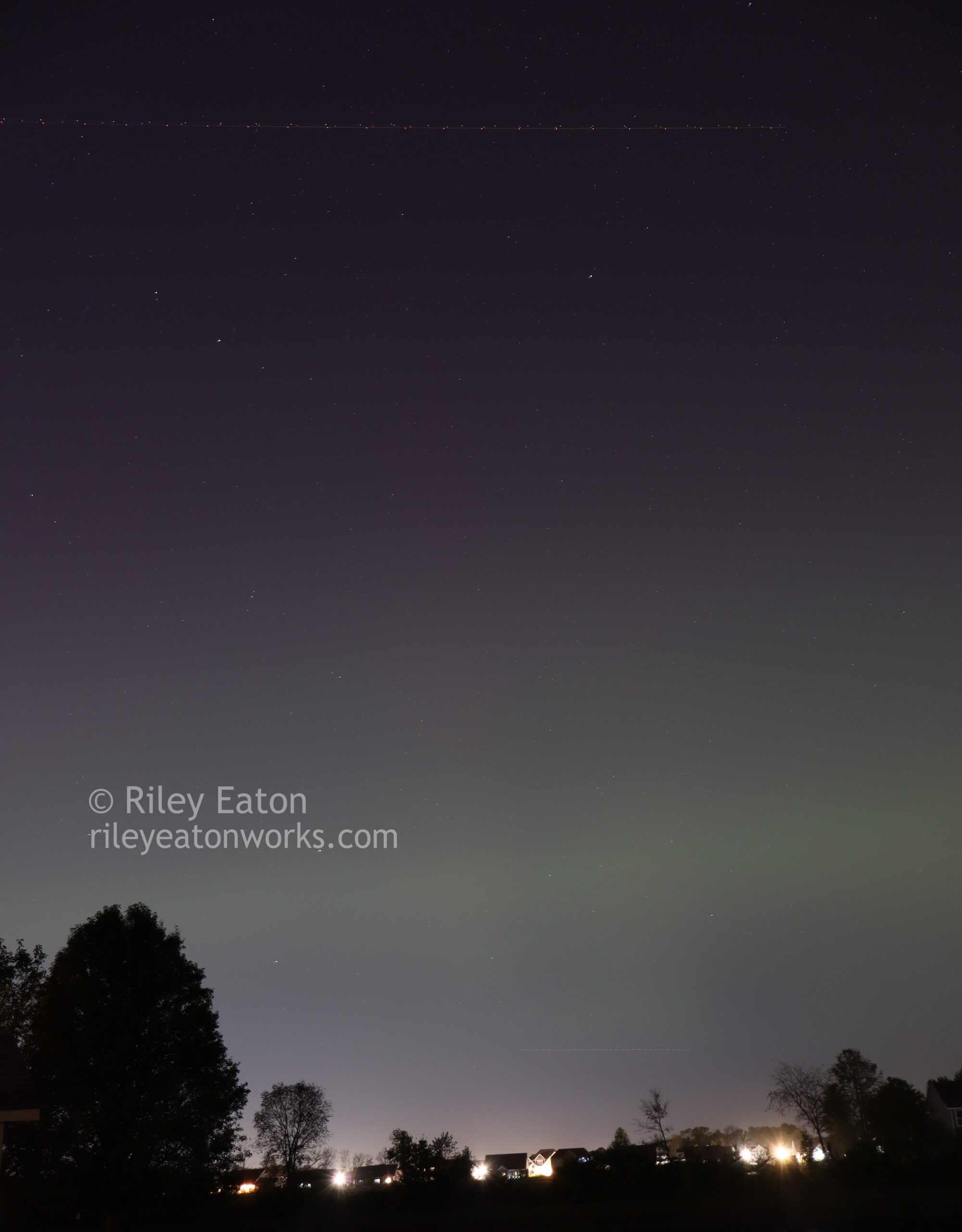Cover image was taken last year on October 10th, 2025.
On Friday (May 30th 2025), the NOAA Space Weather Prediction Center detected a coronal mass ejection eruption from the sun’s surface and predicted it’d reach the Earth by Sunday, June 1st through Monday June 2nd1. What does that mean? It means Indiana might be getting solar lights tonight (June 1st, 2025) and before sunrise tomorrow (June 2nd, 2025).
Twice last year in October, solar flares caused northern nights to appear in Indiana—the first was barely noticeable if not photo-capturable at all for some Hoosiers, and the second one was definitely capturable on camera for many Hoosiers.
Tonight and potentially tomorrow morning (again, June 1st & June 2nd 2025), these northern lights will be visible to only-visible-on-photo as far north as Canada and as far south as northern Texas & northern Georgia2. For me and many of my fellow Hoosiers, we fall in the “only visible on photo” category, with northern Indiana having potential to see the lights with the naked eye.
The only catch? Wildfire smoke from Canada has been and is continuing to swath across midwestern skies this weekend (my thoughts and prayers are with those Canadians impacted by these wildfires).
Wildfire smoke is finnicky with its drift—yesterday, I saw a layer of white smoke across the sky all morning, but it cleared up by noon or 1 PM. Today, who knows how soon or not the skies will clear, if at all. It’s a wait-and-see situation.

If the skies clear enough by dark to take photos, you will have to take a long exposure photo of the sky to capture the northern lights.
How do you take a long exposure shot?
To take a long exposure photo on iPhone, set your phone on a stable surface or tripod with the camera facing north, then turn on the live photos setting3. You should be good to go taking your shot!
If you’re using a third party camera app on your smartphone, an article from solveyourtech.com3 suggests, “You’ll want a low ISO and a slow shutter speed. The exact settings will depend on how much light is in the scene and how fast things are moving.
Experiment with different settings to find what works best for your particular scene. Remember, the longer the shutter is open, the more motion blur you’ll get.
Press the shutter button and wait. The longer the exposure, the more pronounced the effect. After the photo is taken, you can use editing tools to touch up the final image if necessary.”
For a mirrorless camera, there’s a few settings to fiddle with. I shoot with a Canon EOS R100 for example, and these are the settings I use for northern lights using an 18-45mm lens (although this may apply fine for any lens—just noting my lens type in case it makes a difference): face the camera north on a tripod, AV mode, ISO 250 (you may have to try a few shots with different ISO settings until you get what you want—250 was just what worked for the nighttime light levels I shot in last year), f/4.5, exposure time (shutter speed) 30 sec.
Shoutout to all the cool people on the official USA Canon community support forums for helping a rookie like me figure out the appropriate camera settings last year!
Most of all, whether an iPhone user or a camera user: try your best to touch or move your device as minimally as possible while pressing the shutter button or waiting for the photo to finish capturing. Long exposure photos are sort of like a time-lapse image, so if the camera if moved at all, the photo will come out shaky or blurry.
Happy sky-hunting, North America!
References
1 Meterologist Matt Standridge. “A rare G4 storm watch is in effect for late Sunday night and early Monday morning (June 1-2) for northern lights.” Facebook.com.
https://www.facebook.com/mattstandridgewx/posts/pfbid032t1sMWUFCimVDo5e1WHuXucXLRmMZgwaewGhB32wxfVqpCx9gGA1nBXuXV7vW7fCl
Accessed 1 June 2025.
2 Meteorologist Matt Standridge. “We have reached G4 solar storm levels.” Facebook.com.
https://www.facebook.com/mattstandridgewx/posts/pfbid02EMS9gpcK2jeHzY876pGRnkMMQeESPX5sLtojjbEnUKGmJuLkdiSKTVJ8i3bydzqSl
Accessed 1 June 2025.
3 Burleigh, Matthew. “How to Take Long Exposure on iPhone: A Step-by-Step Guide.” Solve Your Tech.
https://www.solveyourtech.com/how-to-take-long-exposure-on-iphone-a-step-by-step-guide/
Accessed 1 June 2025.





Leave a Reply